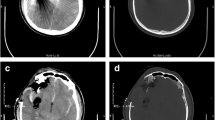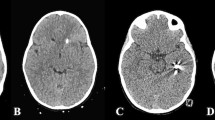Abstract
Intermediate targets (IT) can modify the morphology of an entrance wound, the trajectory of the bullet, and contaminate the path with fragments or material from the target. The penetration into the body of big fragments or even of an entire IT is exceptional and only rarely reported in the literature. The interpretation of a gunshot wound after contact of the bullet with IT can sometimes be very tricky as the classical morphology can be missing. The presented case is a rare example of atypical entrance wound and path due to a surprising intermediate target of a gunshot fired against the head.



Similar content being viewed by others
References
Saukko P, Knight B (2004) Knight’s forensic pathology, 3rd edn. Hodder & Arnold, London
DiMaio VJ (1999) Gunshot wounds: practical aspects of firearms, ballistics, and forensic techniques, 2nd edn. CRC Press LLC, Boca Raton
Saternus KS (1992) Kopfschuß: Spannungsfeld zwischen Medizin und Recht. Schmidt-Römhild, Lübeck
Pollak S (1982) Zur Makro- und mikromorphologie der durch Faustfeuerwaffen erzeugten Einschusswunden. Beitr Gerichtl Med 40:493–520
Dettmeyer RB, Verhoff MA, Schütz HF (2014) Forensic medicine: fundamentals and perspectives. Springer, Berlin Heidelberg
Spitz WU (2006) Spitz and Fisher’s medicolegal investigation of death: guidelines for the application of pathology to crime investigation, 4th edn. Charles C Thomas Publisher LTD, Springfield
Pollak S, Wieser I (1988) Zähne als Zwischenziel – eine Ursache für die rasche Zerlegung von militärisch verwendeten Vollmantelgeschossen. Wien Klin Wochenschr 100(22):729–33
Dixon DS (1982) Tempered plate glass as an intermediate target and its effects on gunshot wound characteristics. J Forensic Sci 27(1):205–8
Molina DK, Rulon JJ, Wallace EI (2012) The atypical entrance wound: differential diagnosis and discussion of an unusual cause. Am J Forensic Med Pathol 33(3):250–2
Thali MJ, Kneubuehl BP, Dirnhofer R, Zollinger U (2001) Body models in forensic ballistics: reconstruction of a gunshot injury to the chest by bullet fragmentation after shooting through a finger. Forensic Sci Int 123(1):54–7
Vermeij E, Rijnders M, Pieper P, Hermsen R (2012) Interaction of bullets with intermediate targets: material transfer and damage. Forensic Sci Int 223(1-3):125–35
Breitenecker R, Senior W, Shotgun patterns I (1967) An experimental study on the influence of intermediate targets. J Forensic Sci 12(2):193–204
Challener RC, Rosenberg SB (1986) An unusual shotgun injury pattern produced by an intermediate target. Am J Forensic Med Pathol 7(3):249–51
Coe JI, Austin N (1992) The effects of various intermediate targets on dispersion of shotgun patterns. Am J Forensic Med Pathol 13(4):281–3
Vennemann B, Dautel F, Braunwarth R, Strassburger E, Hunzinger M, Pollak S, Grosse Perdekamp M (2008) Textile fibres along the bullet path—experimental study on a skin-gelatine composite model. Int J Legal Med 122(3):213–8
Carr D, Kieser J, Mabbott A, Mott C, Champion S, Girvan E (2014) Damage to apparel layers and underlying tissue due to hand-gun bullets. Int J Legal Med 128(1):83–93
Tian HM, Huang MJ, Liu YQ, Wang ZG (1982) Primary bacterial contamination of wound track. Acta Chir Scand Suppl 508:265–9
Rothschild MA, Mülling C (1998) Morphologischer Nachweis von Bacillus cereus in Knallkartuschen. Arch Kriminol 201(5–6):172–81
Rothschild MA, Liesenfeld O (1996) Is the exploding powder gas of the propellant from blank cartridges sterile? Forensic Sci Int 83(1):1–13
Wolf AW, Benson DR, Shoji H, Hoeprich P, Gilmore A (1978) Autosterilization in low-velocity bullets. J Trauma 18(1):63
Mallak C, Chute D, Smialek J (1998) A penny (or peso) for your thoughts: an unusual intermediate target. Am J Forensic Med Pathol 19(3):230–3
Thali MJ, Kneubuehl BP, Rodriguez WR, Smirniotopoulos JG, Richardson AC, Fowler D, Godwin M, Jurrus A, Fletcher D, Mallak C (2009) Coins as intermediate targets: reconstructive analysis with synthetic body models. Am J Forensic Med Pathol 30(2):159–61
Murphy GK (1981) Gunshot wound of the chest with five intrathoracic foreign bodies. Am J Forensic Med Pathol 2(2):163–6
Author information
Authors and Affiliations
Corresponding author
Rights and permissions
About this article
Cite this article
Egger, C., Schrag, B., Brunel, C. et al. An extraordinary case of an intracranial foreign body after a gunshot to the head. Int J Legal Med 129, 149–152 (2015). https://doi.org/10.1007/s00414-014-0993-1
Received:
Accepted:
Published:
Issue Date:
DOI: https://doi.org/10.1007/s00414-014-0993-1




